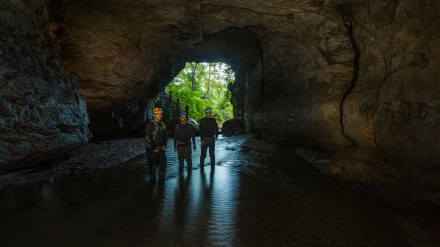The undulating, verdant landscape of the Garo Hills is a rich tapestry of mist-laced forests, sacred groves, cascading waterfalls, limestone caves, and resilient indigenous culture. For the discerning traveller in search of unspoiled nature and authentic encounters, the Garo Hills offer a compelling invitation.
Nature’s Theatre
The Garo Hills are divided into East, West, North, South, and South West districts, each with its own distinctive charm. The region is named after the Garo tribe, one of the major hill tribes of Meghalaya, whose deep reverence for nature has helped preserve the area’s ecological wealth.
The Nokrek Biosphere Reserve near Tura, the region’s largest town, is a biodiversity hotspot and a delight for trekkers and wildlife lovers. Home to the endangered western hoolock gibbon, red panda (reported in higher altitudes), and clouded leopard, the forest canopy here hums with life. Nokrek is also believed to be the origin of citrus indica — a wild orange considered the genetic ancestor of all cultivated citrus fruits.
Caves and Cascades
The limestone caves of the Garo Hills are geological wonders. Siju Cave, near the village of Baghmara, is among India’s longest and least-explored cave systems. Known as the “Bat Cave” for its large colony of resident bats, it also contains stunning stalactites and subterranean river passages. The nearby Siju Bird Sanctuary offers sightings of rare and migratory birds including Siberian ducks, grey hornbills, and peafowls.
Waterfalls abound, especially during the monsoon. Pelga Falls near Tura and Rongbang Dare near Williamnagar are serene picnic spots with local flavour. For those who prefer offbeat treks, the trek to Imilchang Dare — a remote waterfall hidden deep in the forest — is a rewarding adventure through dense jungle and whispering bamboo groves.
Trekker’s Delight
Trekking in the Garo Hills is an immersive experience that blends rugged terrain with dense, untouched forest. Trails here are often unmarked and best navigated with local guides, which adds to the sense of discovery. From gentle walks through orange orchards and bamboo groves to more strenuous hikes up to Nokrek Peak — the highest point in the Garo Hills — trekkers are rewarded with panoramic views of rolling hills, mist-draped valleys, and, on clear days, even the Brahmaputra plains in Assam. The route to Nokrek often includes encounters with remote villages, sacred springs, and rare orchids blooming in the wild. For the more adventurous, multi-day treks can connect forest reserves and traditional settlements, offering a rare chance to sleep in thatched huts, listen to forest legends by firelight, and truly disconnect from the modern world.
Culture and Community
The Garo people are warm and welcoming, and their matrilineal society lends a unique flavour to daily life. Villages like Sadolpara, Chisobibra, and Rombagre offer rich glimpses into traditional Garo customs — from bamboo dance performances and rhythmic Wangala drumming to handwoven textiles and rice beer brewing. If you time your visit for November, the annual Wangala Festival — a post-harvest celebration honouring the Sun God — bursts into colour with dance, music, and community feasting. The next festival is on November 7, 2025.
Getting There and Staying
The nearest airport is in Guwahati, Assam, around 200 km from Tura, with shared taxis and buses connecting the route via NH-17. Accommodations are modest but comfortable — circuit houses, forest lodges, and local guesthouses offer a homestay-like experience with traditional meals and Garo hospitality.
Why Now?
The Garo Hills are on the cusp of change, with improved connectivity and an emerging eco-tourism movement. But their soul remains intact — untouched by mass tourism, guarded by forest spirits and tribal lore. For those yearning to go beyond the obvious, to hear cicadas instead of city horns, and to rediscover the joy of journeying slowly — the Garo Hills are waiting.
Disclaimer
This article contains sponsored content that may not reflect the independent opinion or views of FinancialExpress.com. Further, FinancialExpress.com cannot be held responsible for the accuracy of any information presented here. Please consult a certified financial advisor before making any decisions based on this article.
